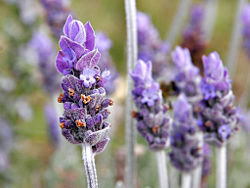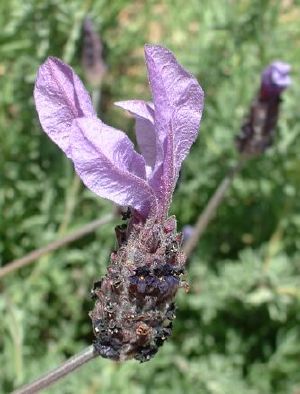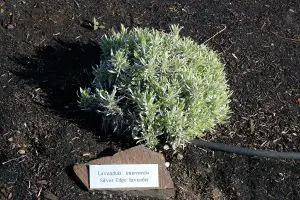Lavender
| Lavender | ||||||||||||
|---|---|---|---|---|---|---|---|---|---|---|---|---|
 Lavender flowers
| ||||||||||||
| Scientific classification | ||||||||||||
| ||||||||||||
|
About 25-30, including: |
The Lavenders Lavandula are a genus of about 25-30 species of flowering plants in the mint family, Lamiaceae, native from the Mediterranean region south to tropical Africa and to the southeast regions of India. The genus includes annuals, herbaceous plants, subshrubs, and small shrubs. The native range extends across the Canary Islands, North and East Africa, south Europe and the Mediterranean, Arabia, and India. Because the cultivated forms are planted in gardens world-wide, they are occasionally found growing wild, as garden escapees, well beyond their natural range.
Uses
The most common species in cultivation is the Common Lavender Lavandula angustifolia (formerly L. officinalis). A wide range of cultivars can be found. Other commonly grown ornamental species are L. stoechas, L. dentata, and L. multifida.
Lavenders are widely grown in gardens. Flower spikes are used for dried flower arrangements. The fragrant, pale purple flowers and flower buds are used in potpourris. Dried and sealed in pouches, they are placed among stored items of clothing to give a fresh fragrance and as a deterrent to moths. The plant is also grown commercially for extraction of lavender oil from the flowers. This oil is used as an antiseptic and for aromatherapy.
Lavender flowers yield abundant nectar which yields a high quality honey for beekeepers. Lavender monofloral honey is produced primarily in the nations around the Mediterranean, and marketed worldwide as a premium product. Lavender flowers can be candied and are used as cake decoration. Lavender is also used as a herb, either alone or as an ingredient of herbes de Provence. Lavender is also used to flavour sugar, the product being called "lavender sugar", and the flowers are sometimes sold in a blend with black tea, as "lavender tea".
French chefs in and around Provence, France have been incorporating this herb into their cuisine for many centuries. Lavender lends a floral, slightly sweet and elegant flavour to most dishes. For most cooking applications it is the dried buds (also referred to as flowers) of lavender that are utilised, though some chefs experiment with the leaves as well. It is the buds however that contain the essential oil of lavender, which is where both the scent and flavour of lavender are best derived.
Medicinal use
Lavender has been used extensively in herbalism.
English lavender, Lavandula angustifolia, yields a highly effective essential oil with very sweet overtones, and can be used in balms, salves, perfumes, cosmetics, and topical applications. French lavender, Lavandula x intermedia, yields a similar essential oil, with higher contents of turpin, which adds a harsher overtone to the fragrance. Spanish lavender, Lavandula stoechas is not used medicinally, but mainly for landscaping purposes.
Essential oil of lavender has antiseptic and anti-inflammatory properties. It was used in hospitals during WWI to disinfect floors, walls and other surfaces.
An infusion of lavender is claimed to soothe and heal insect bites. Bunches of lavender are also said to ward off insects. If applied to the temples, lavender oil is said to soothe headaches. Lavender is frequently used as an aid to sleep and relaxation: Seeds and flowers of the plant are added to pillows, and an infusion of three flowerheads added to a cup of boiling water are recommended as a soothing and relaxing bedtime drink. Lavender oil (or extract of Lavender) is claimed to heal acne when used diluted 1:10 with water, rosewater, or witch hazel; it is also used in the treatment of skin burns and inflammatory conditions (it is a traditional treatment for these in Iran).
Health precautions: There is scientific evidence to support the effectiveness of some of these remedies, especially the anti-inflammatory effects, but they should be used with caution since lavender oil can also be a powerful allergen. Ingesting lavender should be avoided during pregnancy and breastfeeding.[1].
A preliminary finding presented at the Endocrine Society's conference in June 2006 had suggested that shampoos, soaps and body lotions containing lavender and tea tree oils may cause "hormonal imbalances and breast growth in young boys"[2]
History
The ancient Greeks called the lavender herb nardus, after the Syrian city of Naarda. It was also commonly called nard.
During Roman times, flowers were sold for 100 denarii per pound, which was about the same as a month's wages for a farm labourer, or fifty haircuts from the local barber. Lavender was commonly used in Roman baths to scent the water, and it was thought to restore the skin. When the Roman Empire conquered southern Britain, the Romans introduced lavender.
During the height of the Plague, glove makers at Grasse would scent their leathers with lavender oil, and this was claimed to ward off the Plague. This story could have some validity as the Plague was transmitted by fleas, which lavender is known to repel.
Ruud Van Nistelrooy, a soccer player for Real Madrid, advocates the use of Lavender, and has been said to coat his boots in it prior to sleep.
Gallery
ReferencesISBN links support NWE through referral fees
- ↑ Lavender: Precautions, Center for Integrative Medicine
- ↑ Bad Shampoo for Boys? (2004-07-04). Retrieved 2007-03-20.
- Lavender of Provence, France. Retrieved 2007-02-17.
- Longe, J. L. 2005. The Gale Encyclopedia of Alternative Medicine. Farmington Hills, Mich: Thomson/Gale. ISBN 0787693960.
External links
Medicinal use
- Medicinal use: University of Maryland Medical Center
- Medicinal use, Modern and Historical: botanical.com
- Details on all varieties of lavender plants.
Cultivars
Credits
New World Encyclopedia writers and editors rewrote and completed the Wikipedia article in accordance with New World Encyclopedia standards. This article abides by terms of the Creative Commons CC-by-sa 3.0 License (CC-by-sa), which may be used and disseminated with proper attribution. Credit is due under the terms of this license that can reference both the New World Encyclopedia contributors and the selfless volunteer contributors of the Wikimedia Foundation. To cite this article click here for a list of acceptable citing formats.The history of earlier contributions by wikipedians is accessible to researchers here:
The history of this article since it was imported to New World Encyclopedia:
Note: Some restrictions may apply to use of individual images which are separately licensed.







